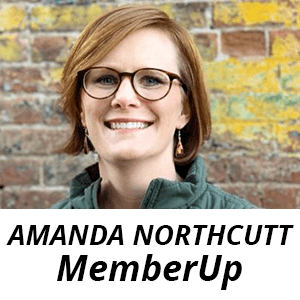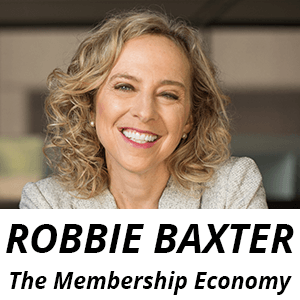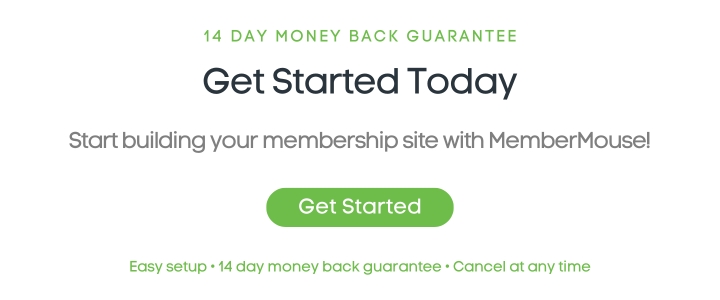5 Membership Experts Share Their Top Member Retention Strategies
Let’s face it, one of the biggest challenges you’ll encounter while running a membership site or subscription business is member retention.
While you might think that getting someone to join your membership in the first place is the hard work, it’s really only half the battle (and that might be the easy half).
The real work begins once someone signs up for your membership or becomes a subscriber. Now you have to deliver the value they are expecting. It won't take long for your new members to see whether or not you've got the goods and can actually fulfill the promises you made in your marketing.
Here's the thing, if you can’t retain a member, you will never truly reap the rewards of the membership business model: consistent and compounding recurring revenue.
In order to help you with your own member retention strategy, we’ve compiled perspectives and advice from five different membership and subscription business experts. After you read this article, we think you'll have a much better understand of what it takes to retain your members.
Give Your Members A Good Reason To Join (And A Better One To Stay)
For nearly 10 years, Luke Ward built and grew a music education membership site called BassGorilla. He worked hard to make his initial offer appealing to his prospective customers. But, he worked even harder to give his members a compelling reason to stay in his membership and get involved with the community.

“You've got to have a very solid reason why someone would want to pay you a recurring subscription every month. At BassGorilla, we worked on our offer and the community aspect, and eventually it started working really well.
We worked hard on what our members had access to. If they only have access to courses that's one thing. But, if they have access to a community where they can get to know like-minded people, ask questions, things like that, that's another thing entirely. Part of this was that we introduced a music feedback section of the community where people could post their tracks or works in progress and get feedback from other members to help them improve.
Another thing we did to improve our offer was I reached out to a lot of music software companies and asked them if they'd be willing to offer some kind of discount or coupon code for our community of members. I got about 15 of them agree to that. That's just another part of the offer that makes it more appealing, because if you can save money on music plugins, then that would end up more than covering the cost of your membership in many cases.
Fostering a really solid community is a great thing to do. Once you have that community in place, you're able to get feedback from them on what's not so good about your site, what is great about your site, but also what kind of content they want.
So, when you're making content based on what your members are asking for, then it's going to appeal to more and more similar people who are in that niche. So, I think that the community aspect of having a membership site is a really solid one and it really helped to create a very, very solid community for us.”
Learn more from Luke in this episode of our podcast: How To Start, Grow, And Sell A Membership Site
Design Your Onboarding To Support Member Retention
Amanda Northcutt is a revenue strategy consultant for online businesses with recurring revenue models. In plain English, she helps membership and subscription business earn more money. She is incredibly smart and takes a practical, systematic approach to increasing profits.
For her, one of the highest-leverage factors in increasing your member retention is your onboarding strategy. How you welcome your new members and get them situated in your membership can have a huge impact on whether or not they stay with you for the long haul.

“Onboarding is so pivotal. Now that somebody is inside your membership, you want to get them to value recognition as fast as possible. Once your members know the benefits they can receive from the features inside your membership, the onboarding teaches them how to actually recognize and achieve those promised benefits.
For example, if you know that the most important thing a new member can do or the biggest indicator of retention is participating in your discussion forum, really early on in your onboarding, you're going to want to make it super easy for someone to jump in and introduce themselves, and start talking to other members.
Here's another example: if you know that starting a specific course is a key retention behavior, you want to point people towards starting that course very early on or consuming XYZ pieces of content. So, you have to know how your current members are using and getting the most benefit from your site, then turn that around and use that information and social proof in your marketing and then onboarding.
One great member retention tactic that I've seen employed on multiple membership sites is sending out a weekly or twice monthly or once a month email that says, ‘Hey, here's what's going on in the discussion forum. Here's what content we put out. Here's the results some of our members are getting.’ Tease what's coming up next.
Do this especially in your onboarding sequence. I think it's really important to tease future content especially if there's an exit ramp at the end of the 30-day trial. A lot of people jump off there. So, you've got to tease future content to keep them, or to get that first payment recognized, and then you go from there obviously.”
Learn more from Amanda in this episode of our podcast: Mastering Recurring Revenue: From Startup to 8-Figures
Understand Churn: The Nemesis Of Member Retention
Carl Gold is the Chief Data Scientist of Zuora – a software platform that helps Fortune 500 companies manage nearly every aspect of their subscription and membership businesses.
As a data scientist, Carl has the unique opportunity to see the membership and subscription industry as a whole from a very high vantage point. Over the years, he’s come to identify and understand major trends across the industry. But of all the things that can impact a recurring revenue business, he’s zeroed in on the one major problem that plagues all membership and subscription businesses: CHURN.

“The most basic definition is that churn is your customers quitting. And it's typically in a subscription context. So, there's an actual cancellation of a subscription. That's what churn is at the highest level.
If you want to increase the number of customers you have and grow your business, it helps a lot if you're not losing customers all the time. Churn is a straight drag on your growth. If you're acquiring 10% new customers every quarter, but you're churning out 5% then you're only growing at 5%. It's simple arithmetic.
Now, there's specific metrics around churn. One being the standard churn rate: the percentage of your customers that have quit or cancelled in a given period. People typically measure either monthly churn or annual churn.
Many businesses also instead use a revenue base churn calculation, which you can just call revenue churn. It’s the same basic idea. It's how much revenue of the customers who quit as a percent of the total. Revenue churn is important to understand when your customers pay a wide variety of prices.
There are also different types of churn that people recognize. The most common distinction is between a voluntary and involuntary churn. Although personally, I don't like the term. When people say involuntary churn, I prefer to call it passive churn.
Let’s define it: Involuntary or passive means that the customer failed to pay. This usually has to do with the payment card failure, either an invalid card number, expired card, or unavailable balance. So, in a passive churn, the service cuts off the customer for nonpayment.
A voluntary churn is more like your classic churn where the customer calls up and says, ‘I'm done.’ Or maybe they do it on the website, they click cancel. That's a voluntary churn. I don't like to call the involuntary churns, involuntary. I prefer the term passive because when you say involuntary churn, it's sort of implies that the customer wanted to stay, but they couldn't.”
Learn more from Carl in this episode of our podcast: How To Fight Churn With Data
Learn To Solve “Forever Challenges” For Your Members
Robbie Baxter is a membership business expert, world-renowned keynote speaker, and the best-selling author of The Membership Economy. Throughout her career, she’s consulted for entrepreneurs, small businesses, and Fortune 500 companies. Her clients include a few companies you may have heard of: Netflix, SurveyMonkey, and eBay.
Robbie is truly an expert when it comes to designing businesses that are equipped to retain customers. For her, your member and subscriber retention plan should actually be built into the foundation of your business. Retention is less a “strategy” and more a fundamental concern that is ideally addressed in your core offering.

“The first thing to think about is this: are you providing enough value that it's worth more than nothing? That's the biggest hurdle that it's worth more than free because there's so much out there that's available for free. You really have to start by thinking ‘What do I have that's worth paying for?’
The second thing to think about is this: is your offering optimized for a subscription? For example, if I'm going to teach you how to tie a tie, it probably wouldn't justify a subscription. No matter how much you want to tie a tie, once you learn it there's not much more that you can learn. You're probably not going to want to talk about it with other people and you’re not going to have ongoing questions.
I see all the time that people have one piece of information, one piece of content, something very narrow and they want to do a subscription. Then they're surprised when people cancel. In that case, the cancellation is completely justified because they've taken all the value out of your subscription that there is to take.
So, step one is to pick a foundational business model and an offering that will actually support people paying you on a month-to-month basis. What type of businesses are those? Anything where the subscriber or member has a what I call a ‘forever challenge.’ Something that's going to go on for an extended period of time and where the organization or the business can provide a forever promise to justify a long-term relationship.
I have not seen much of correlation between price and retention rates. What I have seen is that the bigger issue is between people thinking that something is valuable and not valuable. They're less sensitive about the actual specific price, unless the pricing is significant outlier well above $5 to $15 that we see most of the time for content.
There is a clear correlation between perception of value and cancelling and I see a clear correlation between usage and canceling. That's probably a better thing to track. Are people using it on a regular basis? If they are, they won't cancel.
That’s why an engagement is a great leading indicator for retention. If people aren't using your content or using your software on a regular basis in the best way, they're probably going to cancel. You can also start to see who's getting the most value in terms of usage.
You can look at what I call the recency, frequency, and depth. When is the last time they logged in? How often do they log in or use your product? Then how deep do they go? Do they use all your features? Do they look at all your content? Do they spend lots of time looking at different things? That's going to show you who's getting the most value. Or, that could be an indicator of who is getting the most value.”
Learn more from Robbie in this episode of our podcast: The Essential Guide to Pricing for Membership Sites
Retain Your Members Through Personal Engagement
Last but certainly not least in our roundup of membership experts is Teresa Heath-Wareing. She’s a brilliant social media marketer, blogger, podcaster, and entrepreneur. She runs a digital marketing agency and earlier this year launched her very own membership site.
Teresa is all about loving her members. In fact, she’s done some things to welcome her members to her community that some people might roll their eyes at in this age of “automation” and “scalability.”
But the result? She has an engaged community full of people forming deep personal and business relationships. And after she launched her membership, Teresa only had ONE cancellation. So we think it’s fair to say she knows a thing or two about member retention. Teresa is a big fan of starting small so that you have the time and energy to go the extra mile for your members.

“Why not start your membership with five, ten, or twenty people? There are some great advantages to starting with a small number of members to begin with. If you want to get going with it and you really want to try it, then you really don't have to wait until you have a massive email list or social media following.
The things that you can do with a smaller group and the learnings that you can take for them and for you are way bigger than you can manage in a larger group. Because when you're large, there are things that you just actually can't do because of the size of it. Whereas starting small, I've been able to do things that I'd never be able to do in a membership that had 200 members.
For example, when I sold the membership, I said I would do one coaching call per month. But actually, I've been doing them every two weeks because I wanted to get to know them and I wanted them to get to know me. I wanted to do some really good quick things and I knew that's where the value would be. I've also thrown in more content for my members than I would normally do.
Another thing I did – which again I could only do because of the size of the group – is that I hand wrote cards to all of them. I will do this again, even if we have more people join. I went and looked at what they did and I tried to write something personal in every single one. And like I said, I wrote everyone. When you start a membership with 30-odd members, it doesn't sound like a lot but I can tell you, it takes time. But, my members’ response from that was amazing.
Writing cards for my new academy members. I am super excited to help them grow their businesses 🙂
If you want to find out more about the academy click here – https://t.co/066yqWrlp4 pic.twitter.com/J5wNExNVx9— Teresa Heath-Wareing (@theathwareing) October 9, 2019
Here’s another thing I've done – which is going to pay dividends going forward – since starting the membership: one of my team members and I sat here the other day and we literally went through every single member. She essentially did a mini-interview on me about who they were.
I answered questions like: Do they have children? Where do they live? How did they know me? Where did they come from? Did they attend the webinar? Did they miss the webinar? I tried to profile these people because again, before you start this process, you think you know who you're attracting and you think you know who you want in there.
We literally say, ‘this person is a social media manager, she has a small freelance agency, she has children, she's trying to manage that, she's doing this. This guy has a product, this guy has a membership, this person has just launched an online course.’ It's basically literally going, ‘Okay, that's who you are.’ But, the other thing that it's helped with when people come on the call and I go, ‘Hi Bridget! How did the membership go?” or ‘How is your course launch?’ Again, that value for me is huge. If someone remembers details about me, it's like you care, you care enough to remember. I think stuff like that is super important.”
Learn more from Teresa in this episode of our podcast: How To Launch A Membership Site From Start To Finish
Wrapping Up
After reading this article, we hope you have a better understanding and perspective about what you can do to better retain your members.
If you would like to learn more from any of the experts featured in this post, we highly recommend you listen to our in-depth conversations on our podcast.
Do you have any questions or comments about what we covered in this article? Leave us a comment below. We'd love to hear from you.
Matt Brown
Over the past 6 years, Matt Brown has worked closely with some of the world's most successful membership and online course entrepreneurs. He's seen first hand what works – and what doesn't – when it comes to starting, building, and growing online businesses. On top of that, Matt was responsible for screening all the guests we've had on the Subscription Entrepreneur podcast. This allowed him to hear the best membership marketing and growth strategies from top authors and experts. Now, he shares everything he learns with you here on the MemberMouse blog. Subscribe today so you can discover cutting-edge strategies that can help you grow your membership, subscription, and online course business.
 Blog
Blog Podcast
Podcast Support
Support Customer Login
Customer Login














